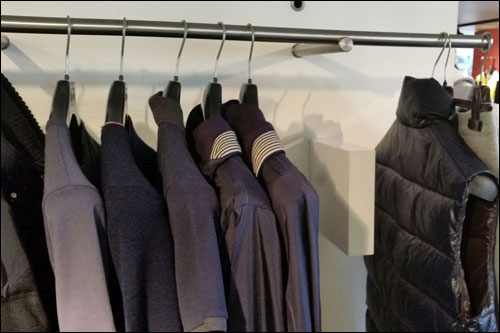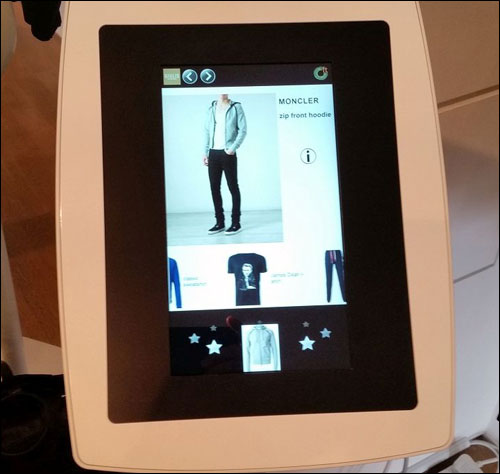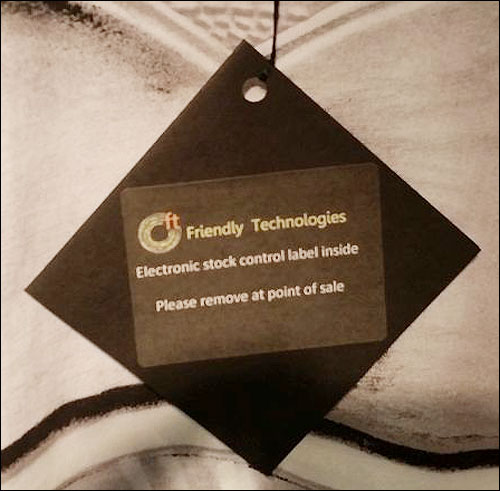Giulio, a fashion store located in Cambridge, England, has completed a four-month trial of a radio frequency identification system designed to track when garments are placed on or removed from a hanging rail, and to display information regarding those products to customers. The retailer now intends to install the technology at additional locations within its store.
The solution, known as an e-rail, was developed by Friendly Technologies, and includes what the company calls Silent Tags, because they respond to an interrogation only if they recognize the reader’s password. The system also comes with software to manage the collected read data and thereby enable applications based on when a garment is placed on or removed from a hanging rail. The store next intends to expand the technology trial to cover more of its products hanging on rails or stacked on shelves.

Humberto Moran, Friendly Technologies’ managing director, draws a distinction between conventional EPC Gen 2 passive ultrahigh-frequency (UHF) RFID tags and readers and Friendly’s proprietary RF Tracking technology, which he says uses a different protocol for identification (though the company’s UHF readers and passive Silent Tags can also operate according to the ISO 18000-6C standard). The system is intended to flip the traditional RFID system on its head, he says: While traditional passive RFID tags simply respond to an interrogation by sending an ID number, in the case of Friendly’s RF Tracking system, the reader assigns and transmits a unique, changeable identifier to each Silent Tag, allowing the tag’s passive UHF chip to respond only if it recognizes that identifier. This process of identifying a tag and assigning it a unique ID is what the company describes as a polling approach. The reader identifies a tag and assigns it a unique 16-bit temporary ID for subsequent polling, then verifies each tag’s continual presence by polling its temporary identity. Because the temporary ID is shorter than the tag’s Electronic Product Code (EPC) number, the transmission process is faster, Moran says. What’s more, since the ID is transmitted from the interrogator to the tag “and not the other way round,” he adds, “the reliability of the system is significantly superior to that of comparable RFID systems.”
Silent Tags can also be switched to standard EPC Gen 2 RFID mode, in which case they would simply respond to any EPC Gen 2 reader without requiring a specific identifier. Friendly Technologies manufactures its own interrogators, while it uses off-the-shelf UHF RFID tags and modifies them to work with the proprietary RF Tracking protocol.
Employing the RF Tracking protocol, Moran explains, enables the tags to be more secure, and to offer better performance than standard RFID. The latter benefit, he says, results from circumventing collision when multiple tags are within the reader’s vicinity, since each tag responds with a much shorter ID. The process can accomplish read rates of up to 500 tags per second in noisy environments. Although some makers of standard EPC Gen 2 readers claim read rates of thousands of tags per second, Moran adds, that can be accomplished only within optimal environments and without the security feature. In addition to reducing collision and thereby increasing reliability, he says, the RF Tracking protocol also offers a higher level of security and privacy, since the tag cannot be read unless the interrogator transmits an authorized ID number to that tag. Thus, if a customer purchases a product at a retail store and carries that tagged item out of the store, he or she can be assured that no reader other than the one at the store can prompt the tag to transmit a response.
At Giulio, Friendly Technologies has installed two e-rails, each consisting of a 3.5-meter-long (11.5-foot-long) rod with two readers, between which tagged items are hung. The tags are attached to men’s jackets and shirts, and can be interrogated whenever they are hanging between those readers. A single e-rail, Moran reports, can support up to 100 garments, offering reliability close to 100 percent.

Giulio also installed a touchscreen wired to the reader. When a garment is removed from an e-rail’s rod, the e-rail software detects a change in the strength of the signal transmitted by that clothing’s tag upon polling, along with any changes in the configuration of the tags hanging between those antennas, thereby enabling it to determine that an item has been removed, as well as identifying that product. The software then prompts the touchscreen to display data about that garment. Therefore, for instance, if a customer removes a wool jacket to examine it more closely, the touchscreen will show information regarding the jacket and list other items that might go well with it. By using the touchscreen, the shopper can then select other specific items and learn more about them, including where within the store they can be found.
Once the garment is placed back on the e-rail, the e-rail software prompts the touchscreen to cease displaying that data after approximately five seconds. This delay time-span is configurable. The software provides analytical data to the store regarding which items are being moved, as well as how often and when.
For shoppers, the system provides what Moran calls a brick-and-mortar equivalent to the click of an item online. Whenever a shopper picks up an item—even if he or she opts not to buy it—that action is detected and noted in the software, indicating that someone looked at that product.
“We hope that this technology will increase sales,” says Giulio Cinque, the store’s owner, adding that it also provides him with valuable data about customers’ shopping behavior. “We believe we’re enriching our customers’ shopping experience, and they will want to return as a consequence. Our customers are trend-driven; they’re excited that we can offer them a connected way to shop.”

Moran says the Silent Tag’s price is about the same as that of a standard EPC RFID tag. The cost of the readers and supporting software is also low, he says, with the aim of making the system affordable to independent retailers.


